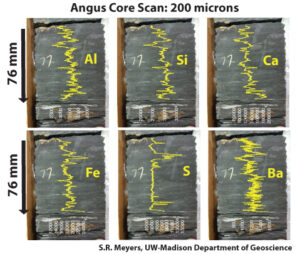
The UW–Madison XRF Scanner Lab houses a third-generation Avaatech core scanner, commissioned in October 2010. The instrument enables rapid automated acquisition of continuous elemental profiles across rock and sediment cores up to 1.8 meters long, at resolutions as fine as 100 microns. The lab is capable of processing sediment and rock cores with diameters ranging from 30 to 140 mm, as well as individual rock and sediment samples, and sediment U-channels. The scanner includes modifications for analyzing extremely soft materials, and also permits 2-D elemental mapping of surfaces.
The UW–Madison scanner is equipped with an Oxford 100 watt X-ray source (rhodium target, beryllium window, 4 – 50 kilovolts, 0 – 2 milliamps, water-forced air-cooled), four filters (aluminum, thin-palladium, thick-palladium, copper), a Canberra X-PIPS SDX15C-150-500 Detector (500 micron silicon crystal, silver collimator, 1 mil beryllium window, Peltier cooler), and a Canberra DSA-1000 Digital Spectrum Analyzer (4096 Channels @ 10 eV/channel). The analytical area (XRF “spot size”) is adjustable from 0.1-10 mm (length down core) x 2-15 mm (width across core), and the position accuracy of the scanner is 5 μm, with variable step sizes from 0.1 to 50 mm.
Example detection limits for some commonly investigated elements are listed below.
Al= 0.2% Si= 0.1% P= 0.05%
S= 0.05% K= 0.04% Ca= 0.02%
Ti= 0.05% V= 15 ppm Cr= 25 ppm
Mn= 100 ppm Fe= 50 ppm Sr= 5 ppm
Ba= 40 ppm Pb= 10 ppm U= 4 ppm
Facility Information
The facility occupies approximately 400 square feet in Weeks Hall for Geological Sciences and provides additional “wet chemistry” capabilities.
Contact
University of Wisconsin-Madison
Department of Geoscience
1215 W. Dayton St.
Madison, WI 53706
Phone: 608-890-2574
Fax: 608-262-0693
E-mail: smeyers@geology.wisc.edu